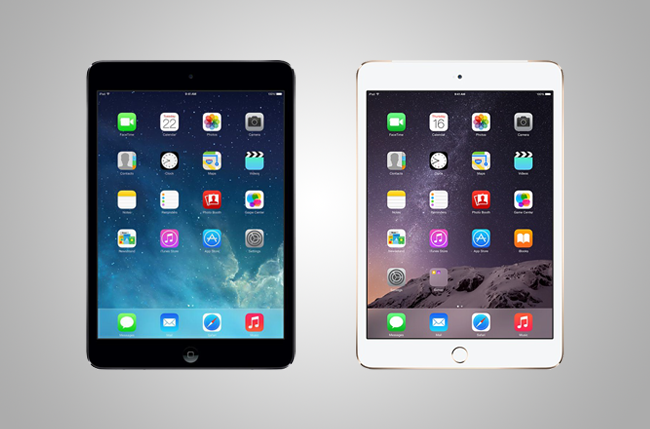
Apple’s invitation to its October 16 press event may have read, “It’s been way too long,” but we all know the company launched the iPhone 6 and unveiled the Apple Watch less than two months ago. Nonetheless, the company recently took to its Cupertin0-based campus to reveal its latest editions to the heralded iPad lineup, including the iPad Air 2 and iPad Mini 3.
Apple decided to add Touch ID and a gold color option to the iPad Mini 3 this time around. It certainly doesn’t boast the sheer number of improvements as the larger iPad Air 2— the larger iPad now has Apple’s A8X processor and an 8-megapixel rear camera — but how does it compete when stacked up alongside last year’s iPad Mini 2 (with the Retina display)? Take a look at the spec comparison below for a quick glance at the internal hardware and software powering both machines. Hint: They’re not that different.
|
Retina iPad Mini 2  |
iPad Mini 3  |
|
| Size | 7.87 x 5.3 x 0.29 (in) | 7.87 x 5.3 x 0.29 (in) |
| Weight | 11.68 ounces | 11.68 ounces |
| Display | 7.9-inch LED with IPS technology | 7.9-inch LED with IPS technology |
| Resolution | 2048 x 1536 pixels | 2048 x 1536 pixels |
| Operating System | iOS 8 | iOS 8.1 |
| Storage | 16 or 32GB | 16, 64, or 128GB |
| Touch ID sensor | No | Yes |
| Processor | Apple’s 64-bit, A7 chip | Apple’s 64-bit, A7 chip |
| RAM | 1GB LPDDR3 DRAM | 1GB LPDDR3 DRAM |
| Camera | Front 1.2MP, Rear 5MP | Front 1.2MP, Rear 5MP |
| Video | Front 720p, Rear 1080p | Front 720p, Rear 1080p |
| Connectivity | Wi-Fi, 4G LTE, HSPA+, Bluetooh 4.0 | Wi-Fi, 4G LTE, HSPA+, Bluetooh 4.0 |
| Sensors | Three-axis gyro, accelerometer, ambient light sensor | Three-axis gyro, accelerometer, ambient light sensor |
| Battery | 8820mAh, 10 hours of Web use via Wi-Fi | 8820mAh, 10 hours of Web use via Wi-Fi |
| Charger | Lightning connector | Lightning connector |
| Marketplace | App Store | App Store |
| Color options | Silver and Space Gray | Silver, Gold, and Space Gray |
| Price | $300+ | $400+ |
| Availability and carriers | Now on AT&T, T-Mobile, Sprint, Verizon | Now on AT&T, T-Mobile, Sprint, Verizon |
| DT review | 4.5 out of 5 stars | 2.5 out of 5 stars |
Power and productivity
Although the iPad Air 2 received a modest update in terms of processing power and internal hardware, the iPad Mini 3 was not as fortunate. The third-generation Mini sports nearly the same hardware specs across the board as last year’s model, most notably Apple’s proprietary A7 processor and M7 coprocessor. Both offerings also feature the same connectivity — Wi-Fi, Bluetooth 4.0, 4G LTE — along with the same internal sensors and a built-in battery that’s intended to last up to 10 hours when surfing the Web via Wi-Fi. However, the iPad Mini 3 does boast the upper hand in terms of storage capacity. Whereas the Mini 2 comes in either 16 or 32GB, the newest models boasts 16, 64, and 128GB capacity.
.
Similarities aside, there is one notable difference between the two iPad Mini models. Apple implemented its Touch ID technology into the Mini 3, allowing users to unlock their device and make software purchases by simply placing their finger on the Home button. Both devices will also utilize the mobile App Store and iOS 8.1 once, that is, assuming iPad Mini 2 users update to the latest version of the mobile operating system.
Design
Apple didn’t try to reinvent the wheel with the iPad Mini 3. The company’s latest tablet still sports the exact same dimensions as its predecessor, as well as the previously-optional 7.9-inch Retina display first introduced on the iPad Mini 2. Both products comes with an aluminum rear shell and chamfered edges, though, the iPad Mini 3 is available in Gold in addition to Space Gray and Silver. Resolution and weight are identical as well, at 2048 x 1536 pixels and 11.68 ounces, respectively, as is the placement of the 3.5mm stereo jack, lightning connector, volume rockers, and other outer components with which everyone is now familiar.
Camera
The iPad Air 2 features an upgraded 8-megapixel rear camera, but as you might have guessed by now, the iPad Mini 3 does not. With an f/2.4 aperature and five-element lens, the rear camera touts the same qualifications as its predecessor, allowing users to capture 5-megapixel stills and 1080p HD video using a bevy of on-board features. Autofocus, face detection, HDR capabilities, a hybrid IR filter also come standard on both devices, as does the FaceTime HD camera for capturing the 1.2-megapixel stills and 720p HD video. Both feature video stabilization and can can capture time-lapse and slo-mo videos as well, with the additional option to create 43-megapixel panorama stills with the introduction of iOS 8. Basically, each device showcases the same camera.
Price and availability
Internal specifications aside, there is a difference between the iPad Mini 2 and iPad Mini 3 when it comes to pricing. Apple dropped the introductory price of the Mini 2 from $400 to $300 with the introduction of its latest 7.9-inch tablet, along with the price of all other iPad Mini 2 models. The baseline pricing for the iPad Mini 3 now begins at $400 for the 16GB, Wi-Fi model, while Apple priced the cheapest cellular model at $530. Furthermore, the Mini 3 is available on the same carriers as its predecessor — AT&T, Verizon, Sprint, and T-Mobile — with pre-orders beginning on October 17. The iPad Mini 2 is the better deal.
| iPad Mini 2 | iPad Mini 3 |
| 16GB: $300 Wi-Fi, $430 cellular | 16GB: $400 Wi-Fi, $530 cellular |
| 32GB: $350 Wi-Fi, $480 cellular | 64GB: $500 Wi-Fi, $630 cellular |
| 128GB: $600 Wi-Fi, $730 cellular |
Conclusion
The iPad Mini 3 is not a vast improvement over the Mini 2. It’s identical in nearly all aspects, from the last-gen processor to the built-in camera, with a higher price tag to boot. Its sole appeal lies in the Touch ID sensor, which isn’t all that enticing for most users. The extra $100 does open the door for the Gold model of the iPad Mini 3 as well, but unfortunately, an additional color offering doesn’t render it as enticing an update as the one Apple gave the iPad Air 2. I guess there’s always next year.



